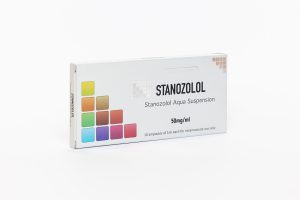Pharmacodynamics
Anabolic steroids are synthetic derivatives of Testosterone. Stanozolol has been found to increase low-density lipoproteins and decrease high-density lipoproteins. These changes are not associated with any increase in total cholesterol or triglyceride levels and revert to normal on discontinuation of treatment. Hereditary angioedema (HAE) is an autosomal dominant disorder caused by a deficient or non-functional C1 esterase inhibitor (C1INH) and clinically characterized by episodes of swelling of the face, extremities, genitalia, bowel wall, and upper respiratory tract. In small clinical studies, Stanozolol was effective in controlling the frequency and severity of attacks of angioedema and in increasing serum levels of C1INH and C4. Stanozolol is not effective in stopping HAE attacks while they are under way. The effect of Stanozolol on increasing serum levels of C1INH and C4 may be related to an increase in protein anabolism.
Pharmacokinetic
Reverses catabolic processes and negative nitrogen balance by promoting protein anabolism and stimulating appetite if there is concurrently a proper intake of calories and proteins.
Contraindications
The use of Stanozolol is contraindicated in the following: Male patients with carcinoma of the breast or with known or suspected carcinoma of the prostate; arcinoma of the breast in females with hypercalcemia; androgenic anabolic steroids, may stimulate osteolytic resorption of bone. Nephrosis or the nephrotic phase of nephritis. Stanozolol can cause fetal harm when administered to a pregnant woman. Stanozolol is contraindicated in women who are or may become pregnant while taking this drug, the patient should be apprised of the potential hazard to the fetus.
Drug interactions
Anabolic steroids may increase sensitivity to anticoagulants; therefore, dosage of anticoagulants may have to be decreased in order to maintain the prothrombin time at the desired therapeutic level.
Pregnancy and lactation
Pregnancy category X. This means that Stanozolol is known to cause birth defects in an unborn baby. Do not take this medication if you are pregnant or could become pregnant during treatment. It is not known whether Stanozolol passes into breast milk. Do not take this medication without first talking to your doctor if you are breast-feeding a baby.
Adverse effects
Hepatic: Cholestatic jaundice with rarely, hepatic necrosis and death. Hepatocellular neoplasm’s and peliosis hepatis have been reported in association with long term androgenic anabolic steroid. Reversible changes in liver function tests also occur including increased bromsulphalein (BSP) retention and increases in serum bilirubin, glutamic oxaloacetic transaminase (SGOT), and alkaline phosphatase. Genitourinary System: In men, Prepubertal: Phallic enlargement and increased frequency of erections. Postpubertal: Inhibition of testicular functions, testicular atrophy and oligospermia, impotence, chronic priapism, epididymitis and bladder irritability. In women: Clitoral enlargement, menstrual irregularities. In both sexes: increased or decreased libido. CNS: Habituation, excitation, insomnia, and depression. Gastrointestinal: Nausea, vomiting, diarrhea. Hematologic: Bleeding in patients on concomitant anticoagulant therapy. Breast: Gynecomastia. Larynx: Deepening of the voice in women. Hair: Hirsutism and male pattern baldness in women. Skin: Acne (especially in women and prepubertal boys.) Skeletal: Premature closure of epiphyses in children. Fluid and Electrolytes: Edema, retention of serum electrolytes (Sodium, chloride, potassium, phosphate, and calcium).
Overdose
An overdose of this medication is unlikely to threaten health. Symptoms of Stanozolol overdose are not known.
Presentation
5 ampoules are packed in a plastic tray. 2 such trays are packed in carton box. All pack sizes may not be marketed.

